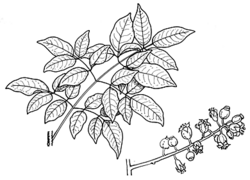Common name: celery wood, silver basswood, black pencil cedar
Polyscias elegans (C.Moore & F.Muell.) Harms APNI* Synonyms: Tieghemopanax elegans (C.Moore & F.Muell.) R.Vig. APNI*
Tieghemopanax elegans (C.Moore & F.Muell.) R.Vig. APNI*

Description: Sparingly branched tree to 30 m high, glabrescent.
Leaves usually 2-pinnate (except for some on flowering shoots only 1-pinnate and with 5–9 leaflets), up to 100 cm long, secondary rachises to 12 cm long, commonly subtended by leaflets; petiole circular in cross section; leaflets with branched hairs when young, ovate to elliptic, mostly 5–12 cm long, mostly 3–6.5 cm wide, apex acuminate, base ± rounded, margins entire; aromatic when crushed.
Inflorescence a terminal panicle, branching 1–3 times, with a grey indumentum, flowers solitary and arranged racemosely along inflorescence branches. Calyx an undulate rim. Petals purple-black. Ovary 2-locular.
Fruit globose, 5–6 mm long, purple-black when ripe.
Flowering: April–August
Distribution and occurrence: Grows in a range of habitats, often in rainforests, vine thickets, and swales of coastal dune systems; north from Jervis Bay.
NSW subdivisions: NC, CC, SC, ?NT
Other Australian states: Qld
Sometimes cultivated as an ornamental. Crushed fresh leaflets with an odour of celery, thus the common name Celery Wood.
Text by M. J. Henwood & R. O. Makinson
Taxon concept: Flora of NSW 3 (1992)
APNI* Provides a link to the Australian Plant Name Index (hosted by the Australian National Botanic Gardens) for comprehensive bibliographic data
***The AVH map option provides a detailed interactive Australia wide distribution map drawn from collections held by all major Australian herbaria participating in the Australian Virtual Herbarium project.
|


